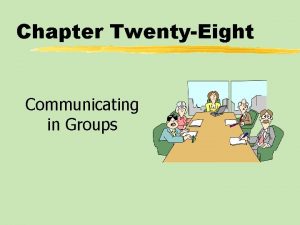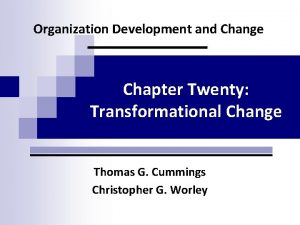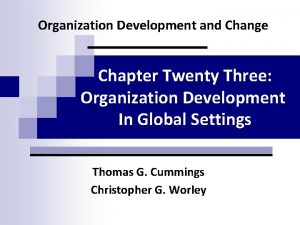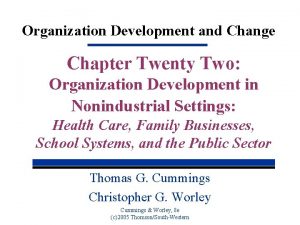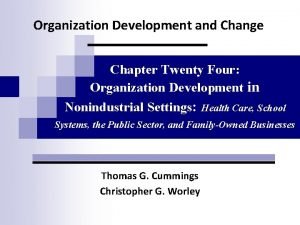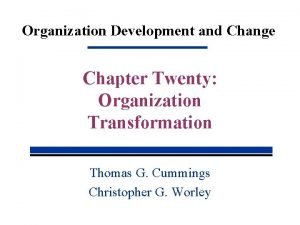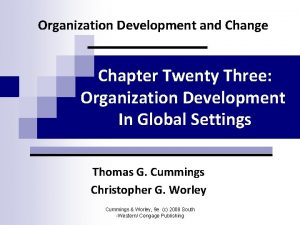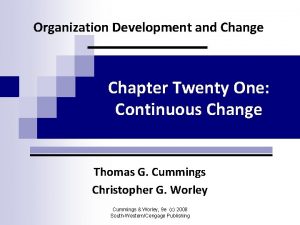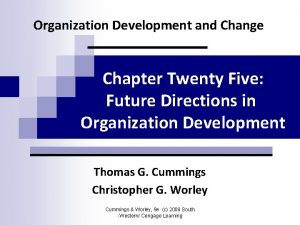Organization Development and Change Chapter Twenty One Organization





















- Slides: 21

Organization Development and Change Chapter Twenty One: Organization Development in Global Settings Thomas G. Cummings Christopher G. Worley Cummings & Worley, 8 e (c)2005 Thomson/South-Western

Learning Objectives for Chapter Twenty One • To explore the differences in OD applications in a cross-cultural context. • To understand the cultural values that might impact OD applications in other cultures • To examine how OD can best be applied in worldwide firms and global social change organizations Cummings & Worley, 8 e (c)2005 Thomson/South-Western 2

Growth of OD in Global Settings • The rapid development of foreign economies • The increasing worldwide availability of technical and financial resources • The emergence of a global economy Cummings & Worley, 8 e (c)2005 Thomson/South-Western 3

Cultural Values • • • Context Power Distance Uncertainty Avoidance Achievement Orientation Individualism Cummings & Worley, 8 e (c)2005 Thomson/South-Western 4

Context • The extent to which meaning in communication is carried in the words • Organizations in high context cultures tend to value ceremony and ritual, the structure is less formal, there are fewer written policies, and people are often late for appointments Cummings & Worley, 8 e (c)2005 Thomson/South-Western 5

Power Distance • Extent to which members of a society accept that status and power are distributed unequally in an organization • Organizations in these cultures tend to be autocratic, possess clear status differences, and have little employee participation Cummings & Worley, 8 e (c)2005 Thomson/South-Western 6

Uncertainty Avoidance • The extent to which members of a society tolerate the unfamiliar and unpredictable • Organizations in these cultures tend to value experts, prefer clear roles, avoid conflict, and resist change Cummings & Worley, 8 e (c)2005 Thomson/South-Western 7

Achievement Orientation • The extent to which people in a society value assertiveness and the acquisition of material goods • Organizations in these cultures tend to associate achievement with wealth and recognition, value decisiveness, and support clear sex roles Cummings & Worley, 8 e (c)2005 Thomson/South-Western 8

Individualism • The extent to which people in a society believe they should be responsible for themselves and their immediate family • Organizations in these cultures tend to encourage personal initiative, value time and autonomy, and accept competition Cummings & Worley, 8 e (c)2005 Thomson/South-Western 9

Cultural and Economic Contexts of International OD Practice Low Level of Economic Development Moderate Cultural Fit with OD Practice High South Pacific South America Middle East High India South Africa Central America Eastern Europe United Kingdom Asia Scandinavia USA Cummings & Worley, 8 e (c)2005 Thomson/South-Western 10

Worldwide Organizations • Offer products or services worldwide • Balance product and functional concerns with geographic issues • Coordination must address complex personnel and cross-cultural issues • Its competitive position in one national market is affected by its global integration and local responsiveness Cummings & Worley, 8 e (c)2005 Thomson/South-Western 11

The Integrative-Responsiveness Framework High Global Orientation Transnational Orientation International Orientation Multinational Orientation Need for Global Integration Low Need for Local Responsiveness Cummings & Worley, 8 e (c)2005 Thomson/South-Western High 12

Worldwide Strategic Orientations • Offer products/services in more than one country • Balance product and functional concerns with geographic issues of distance, time, and culture • Carry out coordinated activities across cultural boundaries using a wide variety of personnel Cummings & Worley, 8 e (c)2005 Thomson/South-Western 13

Worldwide Strategic Orientations • • The International The Global Orientation The Multinational Orientation The Transnational Orientation Cummings & Worley, 8 e (c)2005 Thomson/South-Western 14

International Strategic Orientation • Characteristics of the International Design – Sell existing products/services to nondomestic markets – Goals of increased foreign revenues • Implementing the International Orientation – OD facilitates extending the existing strategy into the new market – Cross-cultural training and strategic planning Cummings & Worley, 8 e (c)2005 Thomson/South-Western 15

The Global Strategic Orientation • Characteristics of the Global Design – Centralized with a global product structure – Goals of efficiency through volume • Implementing the Global Orientation – OD supports career planning, role clarification, employee involvement, conflict management and senior management team building to help achieve improved operational efficiency – OD helps the organization transition to global integration from local responsiveness Cummings & Worley, 8 e (c)2005 Thomson/South-Western 16

The Multinational Strategic Orientation • Characteristics of the Multinational Design – Operate a decentralized organization – Goals of local responsiveness through specialization • Implementing the Multinational Orientation – OD helps with intergroup relations, local management selection and team building – OD facilitates management development, reward systems, and strategic alliances Cummings & Worley, 8 e (c)2005 Thomson/South-Western 17

Transnational Strategic Orientation • Characteristics of the Transnational Design – Tailored products – Goals of learning and responsiveness through integrations • Implementing the Transnational Orientation – Extensive selection and rotation – Acquire cultural knowledge and develop intergroup relations – Build corporate vision Cummings & Worley, 8 e (c)2005 Thomson/South-Western 18

Global Social Change Organizations · Their primary task is a commitment to serve as an agent of change in the creation of environmentally and socially sustainable world futures · They have discovered and mobilized innovative socialorganizational architectures · They hold values of empowerment in the accomplishment of their global change mission · They are globally-locally linked in structure, membership, or partnership and thereby exist as entities beyond the nation-state · They are multi-organizational and often cross-sectoral Cummings & Worley, 8 e (c)2005 Thomson/South-Western 19

Application Stages of Global Social Change Organizations • Build the local organization – Using values to create the vision – Recognizing that internal conflict is often a function of external conditions – Understanding the problems of success • Create horizontal linkages – Build a network of local organizations with similar views and objectives • Develop vertical linkages – Create channels of communication and influence upward to governmental and policy-level, decision-making processes Cummings & Worley, 8 e (c)2005 Thomson/South-Western 20

Global Social Change Organizations OD Roles and Skills • • • Bridging Role Stewardship Role Communication Skills Negotiation Skills Networking Skills Cummings & Worley, 8 e (c)2005 Thomson/South-Western 21
 Twenty one pilots guns for hands
Twenty one pilots guns for hands Willow cabin speech
Willow cabin speech One god one empire one religion
One god one empire one religion One one one little puppy run
One one one little puppy run One king one law one faith
One king one law one faith One empire one god one emperor
One empire one god one emperor Ford one plan
Ford one plan See one do one teach one
See one do one teach one See one, do one, teach one
See one, do one, teach one Studiendekanat uni bonn
Studiendekanat uni bonn Asean tourism strategic plan
Asean tourism strategic plan One vision one identity one community
One vision one identity one community What's a physical change
What's a physical change Absolute change and relative change formula
Absolute change and relative change formula Whats the difference between physical and chemical change
Whats the difference between physical and chemical change Change in supply and change in quantity supplied
Change in supply and change in quantity supplied Physical change
Physical change Rocks change due to temperature and pressure change
Rocks change due to temperature and pressure change Whats chemical change
Whats chemical change First order change adalah
First order change adalah Four score and seven years ago
Four score and seven years ago A small group usually has between three and twenty people.
A small group usually has between three and twenty people.





















